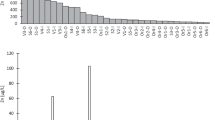Abstract
The role of sediment in the adsorption and desorption of toxic elements and compounds is well known. By these processes, elements are moved from their points of origin to a final sink. Areas of intense human activity are characterized by the production of a large array of toxic materials, many of which may be found in the sediments of a variety of areas in the world. It has been shown, even when sources of elements and compounds have been eliminated, that the recovery rate of such areas is non-existent or slow due to the direct effects of the polluted sediment on the associated ecosystem. This paper briefly discusses the problem and discusses a number of remedial options and their selection. The options include dredging, leaving in place or a series of inactivation methods to be applied in situ. These in situ methods include covering, ploughing and acceleration of the rate of sediment accumulation. Following any remedial action, monitoring must continue to ensure that the system is recovering in a manner that achieves the specified objectives of the remedial plan.
Similar content being viewed by others
References
Durham, R. W. & B. G. Oliver, 1983. History of Lake Ontario contamination from the Niagara River by sediment radiodating and chlorinated hydrocarbon analysis. J. Great Lakes Res. 9: 160–168.
IJC, 1975. International Working Group on the Abatement and Control of Pollution from Dredging Activities. Final Report of the International Joint Commission. International Joint Commission, Windsor, Ontario. 227 pp.
IJC, 1982. Guidelines and Register for Evaluation of Great Lakes Dredging Projects. Report of the Dredging SubCommittee to the Water Quality Board. International Joint Commission, Windsor, Ontario. 365 pp.
IJC, 1983. Evaluation of Dredged Material Disposal Options for Two Great Lakes Harbours using the Water Quality Board Dredging Sub-Committee Guidelines. Report of the Dredging Sub-Committee to the Water Quality Board. International Joint Commission, Windsor, Ontario. 67 pp.
IJC, 1986. A forum to review confined disposal facilities for dredged materials in the Great Lakes. Proceedings of a workshop held by the Dredging Sub-Committee, Toronto, 1985. in press.
IJC, 1986. Guidance on characterization of Areas of Concern in the Great Lakes Basin. Windsor, Ontario, in press.
Mudroch, A., 1983. Distribution of Major Elements and Metals in Sediment Cores from the Western Basin of Lake Ontario. J Great Lakes Res. 9: 125–133.
Thomas, R. L., J. M. Jaquet & A. Mudroch, 1977. Sedimentation processes and associated changes in surface sediment trace metal concentrations in Lake St. Clair, 1970–1974. Proc. of the Int. Conf. in Heavy Metals in the Environment, Toronto, 1975: 691–708.
Thomas, R. L. & A. Mudroch, 1979. Small Craft Harbours — Sediment Survey, Lake Ontario, Erie and St. Clair. Report to Small Craft Harbours, Dept. Fisheries and Oceans, Burlington, Ontario. 149 pp.
Wabigoon-English River Mercury Study Steering Committee, 1984. Mercury Pollution in the Wabigoon-English River System of Northwestern Ontario and Possible Remedial Measures. Technical Report, Governments of Canada and Ontario. 538 pp.
Author information
Authors and Affiliations
Rights and permissions
About this article
Cite this article
Thomas, R.L. A protocol for the selection of process-oriented remedial options to control in situ sediment contaminants. Hydrobiologia 149, 247–258 (1987). https://doi.org/10.1007/BF00048664
Issue Date:
DOI: https://doi.org/10.1007/BF00048664




